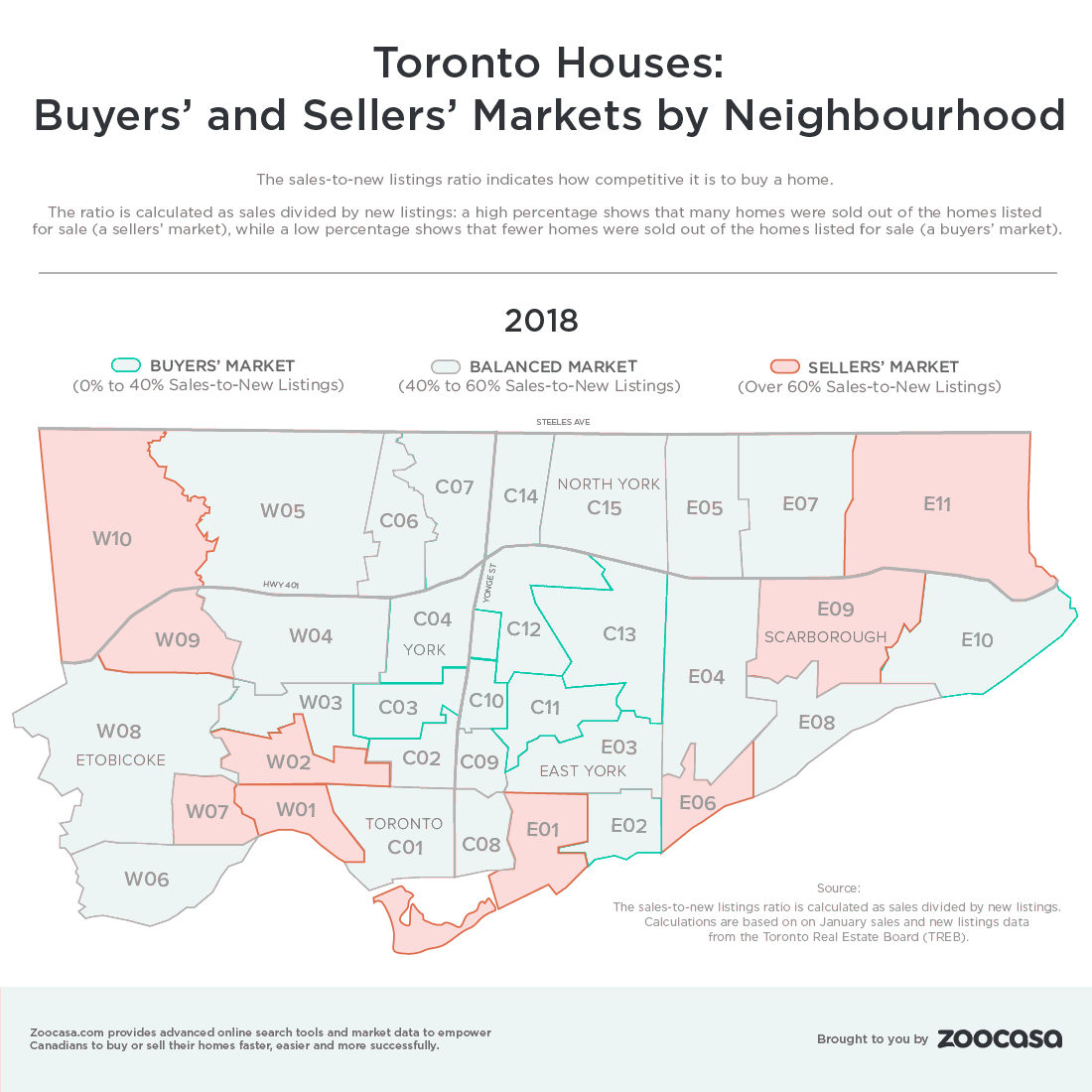There’s no denying the Toronto housing market has experienced a significant shift. According to the latest January data, sales have fallen 22 per cent since last year, halting the rampant price growth that defined the 2016 and 2017 markets. Before we get to the animated infographics below, let's take a look at how we got here ...
A number of new policies introduced over the past six months have impacted Toronto homes for sale. The Ontario Fair Housing Plan, which went into effect last April and included a foreign buyer tax, caused sales to plunge double digits over the usually hot spring season. It did not re-stabilize until autumn. New mortgage rules, which went into effect on January 1, will significantly reduce affordability for anyone getting a new mortgage or refinancing their existing one.
This has all contributed to a new real estate reality for buyers and sellers: The re-emergence of buyers’ markets.
Back to balance
According to data illustrated by Zoocasa, the number of buyers’ markets more than doubled in the City of Toronto between January 2017 and 2018, from five to 11. The number of sellers’ markets, however, fell from 17 to nine — while 15 can now be considered balanced.
But while a return to a more balanced market is good news for buyers, it doesn’t mean houses are now selling for a song; rather, the definition of buyers’, sellers’, and balanced markets refer to the level of competition in any given region, based on its sales-to-new-listings ratio.
This is a metric analysts use to gauge the level of demand in a specific market. It is calculated by dividing the number of sales by the number of homes listed for sale during a specific time frame. For example, the number of sales divided by the number of new listings that came to market in Toronto in January.
A ratio between zero and 40 per cent is a buyers’ market, as less than half of homes listed sold.
A ratio between 40 and 60 per cent is balanced, with approximately half of all listings sold.
A ratio above 60 per cent is a sellers’ market, with more than half of all listings sold.
To put things in perspective, in March 2017 (which we now know was peak Toronto real estate insanity), the City of Toronto boasted a sales-to-new-listings ratio of 74 per cent. This signalled extremely tight sellers’ conditions.
A closer look
Because real estate conditions can change between neighbourhoods, this ratio gives both buyers and sellers more accurate insight than aggregate regional data, which doesn’t always reflect what’s happening on the front lines in hot or slow markets.
For example, a prospective seller may decide to delay listing if their current market has too much existing inventory, or a buyer may narrow their home search to less competitive neighbourhoods. It’s also an effective way to compare activity in different markets, such as demand for Mississauga houses versus those in the 416.
Toronto buyers’ and sellers’ markets over five years
Check out how neighbourhood conditions have fluctuated in Toronto over the past five years in the animated graphs below:
[video width="1100" height="1100" mp4="https://storeys.com/wp-content/uploads/2018/02/MP4-Zoocasa-toronto-buyers-sellers-market-2018-condos.mp4"][/video]
[video width="1100" height="1100" mp4="https://storeys.com/wp-content/uploads/2018/02/zoocasa-mp4-2-toronto-buyers-sellers-market-2018-houses.mp4"][/video]
A look at how house markets (semi + detached) have changed between 2017 and 2018
Neighbourhoods that went from a sellers’ market to a buyers’ market in the last year (became much easier to buy)
- C07 (Willowdale)
- C11 (Leaside, Thorncliffe)
- E10 (Centennial Scarborough, West Hill)
- W03 (Eglinton West, Rockcliffe-Smythe)
Neighbourhoods that went from a sellers’ market to a balanced market (became slightly easier to buy)
- C15 (Don Valley Village, Bayview Village)
- E04 (Wexford Maryville, Dorset Park)
- E05 (L’Amoreaux, Tam O’Shanter-Sullivan)
- E08 (Scarborough Village)
- W04 (Mount Dennis, Yorkdale-Glen Park)
Neighbourhoods that went from a balanced market to a buyers’ market in the last year (became slightly easier to buy)
- C04 (Bedford Park, Lawrence Park South)
- C10 (Mount Pleasant East)
- C13 (Banbury-Don Mills, Victoria Village)
- C14 (Willowdale East)
- E02 (The Beaches, Woodbine Corridor)
Neighbourhoods that went from a buyers’ market to a sellers’ market (became much harder to buy)
None
Neighbourhoods that went from a balanced market to a sellers’ market (became slightly harder to buy)
None
Neighbourhoods that went from a buyers’ market to a balanced market (became slightly harder to buy)
- C09 (Rosedale-Moore Park)
- E07 (Miliken, Agincourt)
How have Toronto condo apartments changed between 2017 and 2018?
Municipalities that went from a sellers’ market to a buyers’ market in the last year (became much easier to buy)
- E05 (L’Amoreaux, Tam O’Shanter-Sullivan)
Municipalities that went from a sellers’ market to a balanced market (became slightly easier to buy)
- C06 (Bathurst Manor)
- C07 (Willowdale West)
- C13 (Banbury-Don Mills, Parkwoods-Donalda)
- C14 (Willowdale East)
- C15 (Don Valley Village, Bayview Village)
- E07 (Miliken, Agincourt)
- E10 (Centennial Scarborough, Rouge)
- W01 (High Park-Swansea)
- w05 (Glenfield-Jane Heights, Black Creek)
- W08 (Etobicoke West Mall, Islington City Centre West)
Municipalities that went from a balanced market to a buyers’ market in the last year (became slightly easier to buy)
- C03 (Oakwood-Vaughan, Forest Hill South)
Municipalities that went from a buyers’ market to a sellers’ market (became much harder to buy)
- E01 (North Riverdale, South Riverdale)
Municipalities that went from a balanced’ market to a sellers’ market (became slightly harder to buy in)
- E09 (Morningside, Woburn)
- W10 (Rexdale-Kipling, West Humber-Claireville)
Municipalities that went from a buyers’ market to a balanced market (became slightly harder to buy)
- C02 (Annex, Yonge-St. Clair)



















